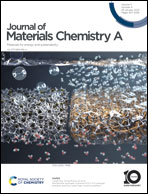Building a rigid-soft coupling interphase by a reduction–oxidation collaborative approach with lithium difluorobis(oxalato) phosphate additives†
Abstract
Optimizing the properties of solid electrolyte interphase (SEI) layers on graphite electrodes is a crucial method for influencing the performance of cells. However, most studies ignore any potential synergistic effects of the reduction and oxidation products of electrolytes and only focus on their individual properties. In this study, we have formatted the pure reduction and oxidation products of lithium difluorobis(oxalato) phosphate (LiDFBOP) on highly oriented pyrolytic graphite (HOPG) and lithiation HOPG surfaces and proved that there is rigid and high viscoelasticity, respectively. Accordingly, a cracked reduction product forming layer is built at a high discharge current. During the following charging process, a low current is used to oxidize LiDFBOP, generating oxidation products that strongly attach to the crack inside. Finally, a multifunctional SEI layer with a gomphosis-like structure is constructed, which prevents lithium dendrite degradation, improves the stability of the interphase layer, and significantly increases the capacity retention of graphite half cells (from 50.2% to 96.7% at 0.5C after 200 cycles). This research opens up new possibilities for logically controlling the SEI production process and clarifies the high-power LIB design strategy.

- This article is part of the themed collection: 2023 Journal of Materials Chemistry A HOT Papers


 Please wait while we load your content...
Please wait while we load your content...